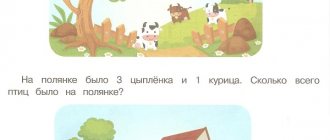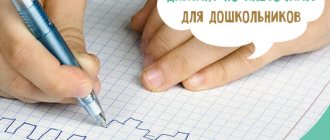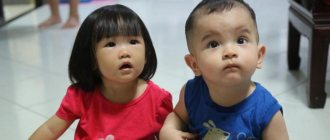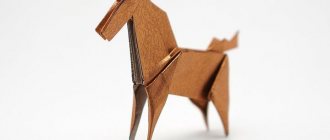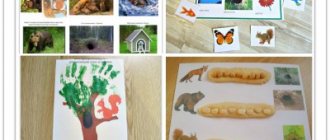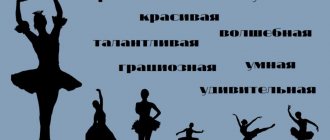We offer for you and your preschool children 5-6 years old examples for counting to 10 in colorful pictures. Such examples are interesting to solve. Simply print out the free worksheets and let your child decide. By devoting 20-30 minutes a day to counting and mathematics, 2-3 times a week, you will perfectly prepare your preschooler for school.
On our website you can download math assignments for free and print them out. Most of the tasks are decorated with colorful drawings and the child will find it interesting to study.
These materials are perfect for children to review the material they have covered during the summer holidays. Repetition of counting, logic, solving examples of addition and subtraction.
Practical material for parents “Math games at home” (5–6 years old) card index
“Math games at home” (5–6 years old)
Numbers. Check
Game “My funny ringing ball” (with a ball)
For example, an adult calls the number 4 (throws the ball) and says:
- “Count further” (and so on with any number up to 10).
- Name the neighbors of the number 4 (5, 6, 9, etc.)
- Name the number that follows the number 2 (3, 4, 6, etc.)
- Name a number that is 1 more (or 1 less than the one named).
Counting in a chain (one at a time).
- The adult starts with “one,” the child continues with “two,” the adult with “three,” the child with “four,” etc. until 10. Then the child starts counting first.
Game “Put aside the same number of objects (counting by ear)
The adult claps his hands rhythmically, the child closes his eyes and counts the claps by ear, then puts away the same number of objects.
- Question: How many items did you put aside? Why?
- Complication: Count 1 more objects (or 1 less than you hear claps.
- Question: How many items have you put aside? Why?
Game "Count the same amount"
There is a large number of objects in front of the child (sticks, circles, buttons, etc.)
- Task: Count out 4 buttons (or any other number up to 10, or count out as many sticks as the number shows (while the adult shows the child any other number within 10).
Game "Wonderful Cup"
Necessary equipment: ten yogurt cups, a small toy that fits in the cup.
- Label each cup with a number.
- Choose a driver. He must look away. During this time, hide a toy under one of the glasses.
- The driver turns and guesses which glass the toy is hidden under. He asks: “Under the first glass? Under the sixth? and so on until he guesses correctly.
- You can answer with prompts: “No, more,” “No, less.”
Game: “Which number is missing?”
- In front of the child is a number row. The child closes his eyes or turns away, the adult removes one or two numbers. Opening his eyes, the child determines which number is missing.
Game: “The numbers are running wild”
All numbers are arranged randomly. Give your child the task of putting the numbers in order.
Connect the number with the required number of objects using an arrow.
Circle the number that corresponds to the number of items.
Game "Name the Number"
In front of the child is a number row. The adult invites the child to show any of the named numbers, or pointing to any number and ask what it is called.
- Tell me which numbers are missing 1 34 6 8 10?
- What number should go instead? 1? ? 4 5? 7? 9 10? and etc.
Game "Guess the number"
The game helps prepare children for basic mathematical operations of addition and subtraction, helps strengthen the skills of determining the previous and subsequent numbers within the first ten
- Ask, for example, which number is greater than three but less than five; what number is less than three but greater than one, etc.
- Children love to guess numbers and guess what they have in mind. Think of a number within ten, for example, and ask your child to guess it. The kid names different numbers, and you say whether the named number is greater than or less than what you had in mind.
- Then switch roles with your child.
Geometric figures
Distinguish and name the shapes: circle, square, triangle, rectangle, trapezoid, rhombus, oval.
Game “Put the object in its place”
There are objects on the table.
- Assignment: round objects - on a round shelf, oval objects - on an oval shelf, etc. (denoting the shelf with the corresponding geometric figure)
Game "Shapes"
Required equipment: counting sticks (or matches).
- Tell your child about basic geometric shapes. Explain what a side and an angle are.
- Together with your child, start making geometric shapes from sticks. Then ask him to do it himself.
- You can give it the required dimensions based on the number of sticks. Invite him, for example, to fold a rectangle with sides of three sticks and four sticks; triangle with sides two and three sticks.
- Try making shapes of different sizes, with different numbers of sticks.
- Teach your child to compare shapes.
- Another option is combined figures, in which some sides will be common. For example, from five sticks you need to simultaneously make a square and two identical triangles, or from ten sticks you need to make two squares - a large and a small one (a small square is made from two sticks inside a large one).
- By combining counting sticks, the child consolidates knowledge of mathematical concepts: “number”, “more”, “less”, “same”, “figure”, “triangle”.
Orientation in space
Game: "Find the object"
Any toys are located in the room (near the sofa, behind the chair, in front of the flower, behind the shelf, on the table)
- Tasks: Find a bunny near the sofa. There's a typewriter behind the chair. In front of the flower is a doll. There's a book behind the shelf. There are notebooks on the table.
- Questions: Where was the bunny? Where was the car? Doll? Book? Notebook?
- Complication: Place the bunny in front of you (behind, left, right, under, near)
Game: "Planes Landing"
In front of the child is a sheet of paper and small airplanes (made of cardboard or toys)
- Tasks: The plane flies to the upper right (left) or lower corner. Where is the plane? The plane flew into the middle of the sheet. Where is the plane? Etc.
- You can play similarly with a puck (black cardboard circle). The puck flies in different directions. Where's the puck?
Game tasks for children
- Stomp your right foot three times.
- Touch your left ear with your left hand.
- Raise your right (left) hand up.
- Place your right (left) foot on your toes.
- Touch your right knee with your left hand.
- Turn to the right (to the left).
- Take three steps forward, turn left, take five steps, etc.
Time orientation
Season
- Know the name of the current season.
- How many seasons are there in total? Name them in order.
- What season comes after spring? etc.
- Name the winter months.
Parts of the day (what we do in the morning; when we walk, sleep, have lunch, wake up, do exercises, etc.)
Days of the week
- What day of the week is the 2nd (3rd, 5th, 6th)?
- Today is Tuesday. What day will it be tomorrow?
- Sunday – what day is it?
- What day of the week will be after Wednesday?
- What day is between Monday and Wednesday?
- How many days are there in a week?
Good luck to you and your children!
Math problems counting up to 20
Task one
Lena had 4 candies, and Olya had 2 candies. How many candies did the girls have?
Left-click on the picture to enlarge it and download it in higher quality.
Math problems for preschoolers
Task two
Sasha made 2 Christmas trees, and Slava 4. How many Christmas trees did the guys make in total?
Task three
There were 5 roses in the vase. Mom cut 2 more. How many roses were in the vase?
Math problems for children 6-7 years old with pictures
Problem four
Petya collected 5 mushrooms, and Masha collected 4 mushrooms. How many mushrooms did the children collect?
Math problems for preschoolers
Task five
There were 4 yellow mugs and 2 purple ones on the table. How many mugs were on the table?
Math problems for preschoolers 6-7 years old
Problem six
2 girls played on the playground, and later 4 more boys came. How many children are there on the playground?
Math problems for children 6-7 years old with pictures
Problem seven
We bought 5 books for the library, and then 3 more books. How many books did you buy for the library?
Math problems for preschoolers
Problem eight
The cat had 5 kittens, 2 kittens were given away. How many kittens does the cat have left?
Math problems for preschoolers 6-7 years old
Problem nine
Anton had 9 cars, he gave 2 cars to a friend. How many cars does Anton have left?
Math problems for children 6-7 years old with pictures
Problem ten
Anya had 5 apples, she gave Olya 2 apples. How many apples does Anya have left?
Math problems for children 6-7 years old with pictures
Problem eleven
Seryozha had a dog, she gave birth to 3 puppies. How many dogs does Seryozha have?
Math problems for preschoolers
Problem twelve
10 balls were brought to the store, the children bought 2 balls. How many balls are left in the store?
Math problems for preschoolers 6-7 years old
Problem thirteen
There were 15 apples in the vase, 6 apples were eaten. How many apples are left in the vase?
Math problems for children 6-7 years old with pictures
Problem fourteen
There were 8 balls on the playground, then we bought 6 more balls. How many balls are there on the playground?
Math problems for children 6-7 years old
Problem fifteen
Roma had 4 red fish, 5 blue fish and 3 yellow fish in his aquarium. How many fish were there in the aquarium?
Problem sixteen
Misha had 20 cubes, he gave 7 cubes to Roma, and 6 cubes to Yura. How many cubes does Misha have left?
Problem seventeen
Vera had 9 dolls, she was given 4 more dolls. How many dolls does Vera have?
Problem eighteen
There were 18 tomatoes growing on the bush. 10 tomatoes are ripe. How many tomatoes are not ripe yet?
Problem nineteen
There were 4 cucumbers, 8 tomatoes, 3 carrots on the table. How many vegetables were on the table?
Problem twenty
The first class made 8 flags, the second class made 9 flags. How many flags did the children make?
Examples in pictures
Examples in pictures are suitable for beginner mathematicians. A visual image will help the child better see the cause-and-effect relationship of changes in quantity.
Download worksheets for solving addition and subtraction examples.
You will find even more examples for preschoolers in the section Adding and Subtracting
Courses for the development of intelligence
We also have interesting courses that will perfectly pump up your brain and improve your intelligence, memory, thinking, and concentration:
Development of memory and attention in a child 5-10 years old
The purpose of the course: to develop the child’s memory and attention so that it is easier for him to study at school, so that he can remember better.
After completing the course, the child will be able to:
- 2-5 times better to remember texts, faces, numbers, words
- Learn to remember for a longer period of time
- The speed of recalling the necessary information will increase
Sign up for a courseRead more
Secrets of brain fitness, training memory, attention, thinking, counting
If you want to speed up your brain, improve its functioning, improve your memory, attention, concentration, develop more creativity, perform exciting exercises, train in a playful way and solve interesting problems, then sign up! 30 days of powerful brain fitness are guaranteed to you:)
Sign up for a courseRead more
Super memory in 30 days
As soon as you sign up for this course, you will begin a powerful 30-day training in the development of super-memory and brain pumping.
Within 30 days after subscribing, you will receive interesting exercises and educational games in your email that you can apply in your life.
We will learn to remember everything that may be needed in work or personal life: learn to remember texts, sequences of words, numbers, images, events that happened during the day, week, month, and even road maps.
Sign up for a courseRead more
How to improve memory and develop attention
Free practical lesson from advance.
Sign up for freeRead more
Money and the Millionaire Mindset
Why are there problems with money? In this course we will answer this question in detail, look deep into the problem, and consider our relationship with money from psychological, economic and emotional points of view. From the course you will learn what you need to do to solve all your financial problems, start saving money and invest it in the future.
Sign up for a courseRead more
Speed reading in 30 days
Would you like to quickly read books, articles, newsletters, etc. that interest you? If your answer is “yes,” then our course will help you develop speed reading and synchronize both hemispheres of the brain.
With synchronized, joint work of both hemispheres, the brain begins to work many times faster, which opens up much more possibilities. Attention , concentration , speed of perception are enhanced many times over! Using the speed reading techniques from our course, you can kill two birds with one stone:
- Learn to read very quickly
- Improve attention and concentration, as they are extremely important when reading quickly
- Read a book a day and finish your work faster
Sign up for a courseFree lesson
We speed up mental arithmetic, NOT mental arithmetic
Secret and popular techniques and life hacks, suitable even for a child. From the course you will not only learn dozens of techniques for simplified and quick multiplication, addition, multiplication, division, and calculating percentages, but you will also practice them in special tasks and educational games! Mental arithmetic also requires a lot of attention and concentration, which are actively trained when solving interesting problems.
Sign up for a courseRead more
Examples within 10
Gradually, the child will be better and better at calculating within 10. To learn how to “crack” examples like nuts, you need to solve a lot. But simply solving the same type of examples is boring. Math should be interesting!
So that your child can practice writing examples at any time, we have come up with ready-made tasks for you. Just download, print and get started!


